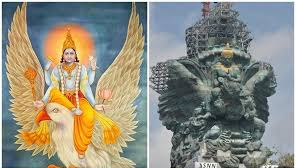 |
| Story Gwk |
Facts and Stories of GWK
The mythology story of the Garuda Wisnu Kencana is a very popular puppet story. Telling the story of the story of Garuda's hard work to free his mother from slavery is the same as the hard work of the Indonesian people to free Mother Earth from colonization by foreign nations.Garuda Wisnu Kencana is a form of Lord Vishnu who is the God of Preservation (Sthiti) in Hinduism riding a Garuda bird. This form comes from the story of Garuda and his kingdom, namely Lord Vishnu who protected the Garuda bird because he had been devoted and sacrificed to save his mother from slavery.
The story begins with a teacher deity named Resi Kasyapa who had two wives. It's just that one of his wives, Kadru, always feels jealous of his other wife, Winata. Several years later, each wife was blessed with a child. Kadru begat Naga while Winata beget Garuda.
One day the two wives had an argument and to solve it they made a bet, guessing the color of the Ucaihswara horse, a flying horse whose shape they did not know. Kadru guesses that the horse is black while Winata guesses that the horse is white. Based on the information Kadru got from Naga, his son, it was true that the horse was white.
So Kadru was restless to hear this news. In that restlessness, Kadru devised a cunning ploy, sending his son to spray the flying horse Ucaihswara with poison so that his white body color turned black.
That's right, when the horse arrived in front of Kadru and Winata, its color had turned black due to the influence of poison. Winata also had to admit her defeat in the dispute and resulted in her becoming Kadru's prisoner forever unless Winata was able to bring the water of immortality, Tirta Amarta.
Garuda, the son of Winata, complied with the request to save his mother from being held captive. So the Garuda began to hunt down the fountain of immortality. On his journey,
Garuda had difficulty getting to the spring, but thanks to Batara Wisnu's help, finally the Garuda managed to get it. In return, Garuda became the riding bird of Batara Wisnu, who became known as the Garuda Wisnu Kencana.
The reality of the sculpting:
Garuda Wisnu Kencana was built in 1997 with capital from BUMN, Bali Tourism Development Corporation (BTDC), and Bali I Nyoman Nuarta, who made the statue. And its construction stopped due to the monetary crisis in 1998, Nyoman as a figure who made Garuda Wisnu Kencana targeting the statue to stand perfectly by the end of 2017.
The name Garuda Wisnu Kencana comes from the names of existing figures, namely Garuda and Wisnu, while kencana means gold because the throne where the statues of Garuda birds and Lord Vishnu stand are covered in gold.
The Garuda Wisnu Kencana (GWK) statue was inaugurated with a 121 meter high statue, on Saturday, September 22 2018. Located on Ungasan Hill, Jalan Raya Uluwatu, Badung Regency, Bali.
Some facts and things masterpiece GWK:
1. Development 28 years
The working time of this statue is up to 28 years. Designed in 1990 with the idea of Nyoman Nuarta and the then Minister of Tourism Joop Ave, and groundbreaking in 1997. The last part is the placement of the slab on the highest part of the eagle tail and completes a total of 754 modules.
2. The 3rd highest in the World
 |
| GWK |
Garuda Wisnu Kencana is the 3rd tallest statue in the world after The Spring Temple Buddha in China which reaches 153 m high and Laykyun Sekkya Buddha as high as 135 meters in Myanmar. GWK has a height of 121m with a wingspan of 65 meters.
readAlso Garuda Wisnu Kencana
3. Involving 120 artists and IDR 450 billion in funds
With a total budget for making this statue reaching Rp.450 billion and to realize his creation by involving 120 artists, Nyoman Nuarta is the initiator and maker of the Garuda Wisnu Kencana statue.
With a total budget for making this statue reaching Rp.450 billion and to realize his creation by involving 120 artists, Nyoman Nuarta is the initiator and maker of the Garuda Wisnu Kencana statue.
4. Designed or designed to be earthquake resistant.
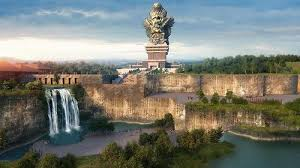 |
| GWK |
The GWK sculpture combines art, technology and science and is designed to withstand wind and earthquake shocks. The statue is designed very sturdy, resistant to earthquake shocks that often occur in Bali and its surroundings.
5. The structure consists of 3000 tons of copper and bronze chips.
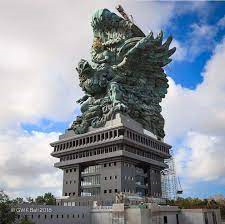 |
| GWK |
The statue consists of copper and bronze plates. consists of the pieces of the statue's body which number up to 300 trucks. The pieces of the statue were made in Bandung and then sent by truck to a workshop near the GWK statue located in Ungasan, Bali. The number of pieces for the GWK statue in Bali reaches a total of 300 trucks or 3,000 tons.
6. The complete complete GWK statue is officially complete after 28 years.
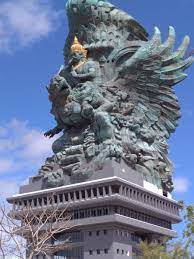 |
| GWK |
The making of the sculpture was carried out by involving 120 artists and it took 28 years where all the same artists were involved. The preparation and completion of the GWK development took 28 years to 31 July 2018. The last module was a copper and brass chip placed on the highest part of the eagle tail and the installation of this last module to complete the number 754.
7. A complete arena venue
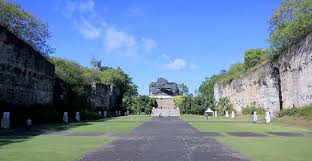 |
| GWK |
There are more than 20 venues in this GWK area. Includes the statue area, Plaza Wisnu, Lotus Pond, Festival Park, Street Theater, Amphitheater to food court.
8. Sturdy Up To 100 Years
It is certain that the design of the statue will be able to stand firm for 100 years with the largest wind capacity of 2.5 kPa. Garuda Wisnu Kencana can stand firmly at a height in any condition.
9. Mutli Discipline Joining Into One
GWK Cultural Park is working with Nyoman Nuarta, as well as consultants and contractors who combine expertise in the fields of art, science and technology so that the statue and the completion of the statue's construction, currently the entire area of GWK Cultural Park can be enjoyed.
10. Involves 1000 skilled workers.
The construction of the GWK Bali statue masterpiece involved 1,000 workers who participated in making the Garuda Wisnu Kencana statue. The division of the total workers is divided into two working areas, namely 400 workers in Bandung, while the other 600 workers work on this project on the Island of the Gods.
11. There is an Eternal Spring
In the GWK area, there is a sacred spring. The local people refer to it as Somaka Giri Temple. It is said that he said, this spring never dries up even though it is the dry season. This spring has been around since the area has not yet been built to become a GWK.
12. Floors totaling 30
 |
| GWK |
The GWK statue has 30 floors if counted. And visitors can only go up to the 23rd floor or the equivalent of the shoulder of the GWK statue. Because, the 30th floor or top of the GWK statue is equivalent to the presence of the head of Lord Vishnu. Of course, the people here consider the head of Lord Vishnu to be sacred and should not be trampled on by just anyone.
13. The most difficult part of the Garuda Wing to install
This Garuda wing stretches 64 m to the right and left. And during the installation, there was an interesting story about the installation of the Garuda wing, which is said to be one of the most difficult parts of the construction of the GWK statue. The installation of the Garuda wing at the GWK must wait for friendly weather and avoid moments of strong winds.
14. Gwk Height Gives the Statue of Liberty
This GWK statue is the 3rd tallest in the world, meaning that the GWK statue's height exceeds the Statue of Liberty in the United States which has a height of 93 meters. After The Spring Temple Buddha in China and The Laykyun Sekkya Buddha in Myanmar. The Garuda Wisnu Kencana statue has a height of 121 meters.
15. Artist I Nyoman Nuarta work
The big name of the famous sculptor I Nyoman Nuarta actually plays a big role behind the splendor of this GWK statue. The maestro of sculpture from Bali is a graduate of the ITB Faculty of Fine Arts. not only the GWK statue, I Nyoman Nuarta is also the maker of the Jalesveva Jayamahe Monument statue in Surabaya.
than u
Tags:
GWK

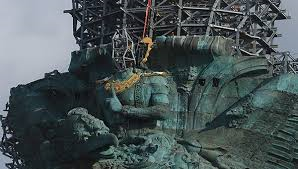
very interesting post , well done
ReplyDelete